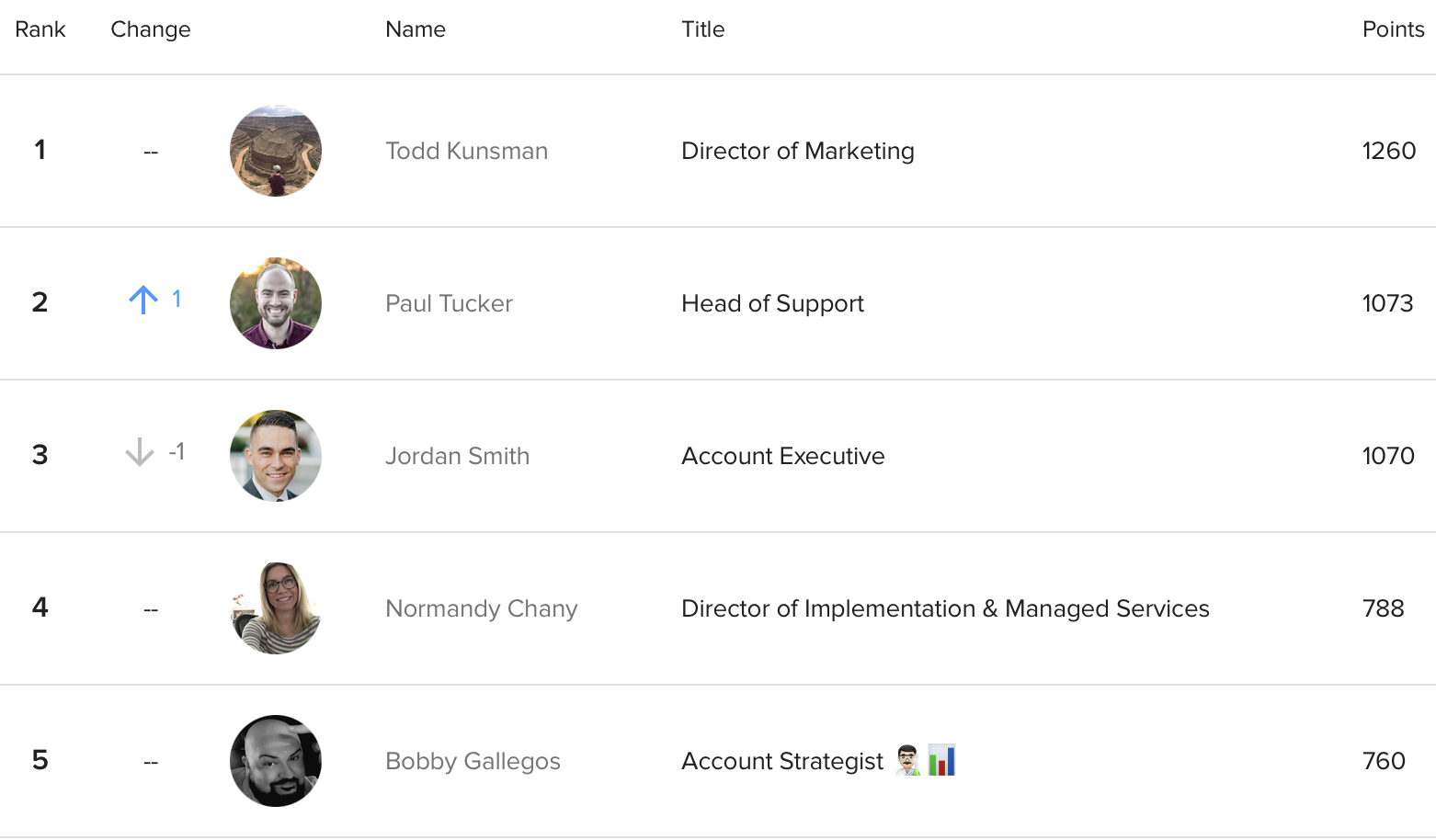Glassdoor recently released its top 100 best places to work, and we weren’t surprised to see several of our customers — including Qualtrics, Workday, Adobe, and Meta — on the list.
Why?
Because our customers believe in the power of employee influencers and invest in their people, which contributes to high levels of employee morale.
Let’s take a look at exactly why employee morale is so important, as well as how you can measure it and steps you can take to improve it at your organization.
What is Employee Morale and Why is it Important?
Employee morale is the attitude or outlook that people have about their work and place of employment.
However, it’s about more than just how an employee feels about their job. It’s also about how they approach their daily tasks, how invested they are in the company’s mission and values, and what kind of attitude they have about the company’s direction.
Employee morale is significant because it’s tied directly to such important things as employee engagement, job satisfaction, employee retention, and overall productivity.
Organizations with high employee morale tend to have healthy cultures, engaged employees, and enviable employer brands.
Those with low employee morale…well, let’s just say they’re not the kind of companies your people will advocate for. At least not in a positive way.
How Can You Measure Employee Morale?
Any workplace could benefit from a morale boost, but the best way to know if your workforce is in dire need of a pick-me-up is to actually measure employee morale. Here’s how to do just that.
Conduct an employee morale survey.
Send out an anonymous survey company-wide to see how people feel about their work, benefits, company culture, and more.
Here are the kind of questions to include:
- On a scale of 1-10, how would you rate employee morale at the company?
- How do you perceive morale at the company?
- Do you get recognition for your work?
- What is your relationship like with your manager?
- Do you feel that leadership cares about you as a person?
- How satisfied are you with your compensation and benefits?
Also, be sure to include a field where employees can provide feedback and make their own suggestions to improve employee morale.
Conduct employee interviews.
Asking your employees directly can be an effective way to gauge employee morale and generate ideas to improve it — but only if people feel comfortable providing honest feedback.
To get the most out of an employee interview — whether it’s one-on-one or in a group situation — you must already have a culture that welcomes feedback and fosters psychological safety.
If employees don’t feel safe expressing their thoughts or feel like the company values them or their opinions, conducting an in-person interview can be a waste of time and an anonymous survey will be a much more effective way to measure employee morale.
Assess engagement levels in your employee influencer program.
If you have a social-sharing or employee advocacy solution in place, you’ve already taken a huge step to boost employee morale. But a tool like EveryoneSocial can also provide excellent insights into how happy and engaged your workers are.
Take a look at how your team uses the program and answer these questions:
- Who’s participating?
- What are they creating and sharing?
- What kind of conversations occur?
- How engaged are employees with internal and external content?

EveryoneSocial makes this kind of assessment a breeze with our ROI dashboard that gives you immediate insights into engagement, reach, clicks, and shares.

Plus, our leaderboard reveals your most engaged users — and motivates them to get more involved.
Observe employees.
Managers are accustomed to keeping an eye on employees to assess their performance and ensure things are running smoothly, but it’s also important to train them to recognize signs of low employee morale.
This can be more challenging in companies that are entirely remote, but managers can still take the pulse of employee attitudes by paying attention to workers’ behavior during calls and video conferences and by observing how they collaborate and communicate via email and other communication tools like Slack.
What kind of behaviors indicate low employee morale? Negative attitudes, missed deadlines, poor work quality, uninformed employees, and an uptick in gossip can all point to a workplace in need of a morale boost.
Analyze the available data.
You may not already have results from a recent employee morale survey, but you no doubt have access to other data that can provide useful insights.
Review employee performance data, training participation records, absenteeism, grievances filed, and any other data your organization tracks that could shed light on workplace morale.
How to Boost Employee Morale
Measuring employee morale — even if you discover that your workforce is in desperate need of a pick-me-up — is a great first step to improving morale because you’ve already demonstrated that your employees’ happiness and job satisfaction is a priority.
Now let’s take a look at several other ways you can boost employee morale at your organization.
1. Live the company mission.
Seventy-five percent of employees believe that well-defined goals and values cultivate a positive work culture, but only 23% of U.S. employees say they can apply their organization’s values to their daily work.
This disconnect contributes to lower morale because employees feel disconnected from their work and the organization as a whole.
The answer? Define your company values and identify ways to incorporate them into every aspect of the organization so that the company truly practices what it preaches.
REI is a great example because its mission to “inspire, educate and outfit for a lifetime of outdoor adventure and stewardship” is central to every aspect of the employee experience, from hiring and training to service projects and company perks, so it’s not surprising the company is consistently rated one of the best places to work.
Organizations like REI that truly live the company mission effectively attract workers whose own values closely align with the company’s, and employees are happier and more engaged as a result.
2. Keep employees informed.
Employees want to be in the know about important company information — this contributes to employee empowerment and allows them to make better decisions.
However, about 75% of employees say they miss out on important company news, and they often cite breakdowns in communication as the cause for most failures at work.
Streamlining your company communications is an effective way to boost employee morale, and it impacts your bottom line as well — connected employees show productivity increases of 20-25%.
Want a simple and effective way to do this? EveryoneSocial’s content newsletters are the answer.

Easily set them up one time and schedule them to send to employees on a regular basis. They automatically pull in trending posts, specific group updates, employee-generated content, and more.
Plus, every employee receives a newsletter customized specifically to them filled with content they haven’t yet engaged with.
3. Make regular feedback part of your culture — and take action.
Employees need to feel they have a voice and that their opinions matter, so give them plenty of opportunities to provide feedback — way more than just an annual engagement survey.
A formal feedback process is great and can include regular surveys and reviews or a virtual suggestion box that employees can submit to anytime.
However, to truly make feedback part of your culture, feedback should be welcomed at every possible opportunity. You can do this by concluding meetings with question-and-answer sessions or encouraging managers to ask employees for their opinions about matters on a day-to-day basis.
Once you have this feedback, show employees that their opinions matter and that you’re committed to making improvements by actually implementing change.
Workers who feel “heard” by leaders are five times more likely to do their best work and the entire organization will experience higher employee morale.
4. Provide top-notch benefits that prioritize employee well-being.
Employees are happier and more productive — and they feel more valued — when their employer provides them with more than just the bare minimum of benefits.
So if you truly want to boost employee morale, take a look at your benefits package.
What do you give your workforce besides a paycheck? Do you provide more than just basic health insurance?
Your benefits package should prioritize well-being, which encompasses not only employees’ physical health, but also mental health, happiness, and professional development.
Workers who feel like their employers invest in their overall well-being are more engaged, more likely to stay, and more likely to recommend the company to others.
Benefits packages can be expensive, but not providing them can take an even larger toll on your bottom line. A Gallup poll found that when employees are least happy and least engaged, the annual per-person cost of lost productivity totaled nearly $30,000.
These days, health insurance, paid vacation, and 401Ks are expected benefits of full-time employment, but there are countless other perks you can provide that’ll show your workforce that you value them and their well-being.
Need a little inspiration of what else to give your employees? Check out the enviable benefits these top companies offer.
5. Strengthen manager relationships.
Managers have an incredible impact on employee morale, and management’s engagement directly affects team engagement.
In fact, 34% of U.S. employees are engaged at work, which aligns with the 35% of U.S. managers who also report being engaged.
Plus, workers say that 75% of great managers have a good attitude and are passionate about their work, which research shows is contagious, positively impacting their subordinates.
But there’s more to great managers than just their own personal engagement.
One of the most effective ways to boost employee morale is to provide workers with managers they trust and respect, and that training begins at the top by coaching leadership on communication, giving and receiving feedback, emotional intelligence, and how to foster psychological safety in the workplace.
6. Offer development opportunities.
To improve employee morale, workers need to feel supported not only in their current roles, but also in future ones. That’s why it’s so important to provide employees with opportunities for their professional development and advancement.
This can take many forms, such as offering one-on-one professional coaching, providing access to programs like LinkedIn Learning, or encouraging employees to attend classes or conventions that the company foots the bill for.

Managers can show their investment in their people by working with employees to develop personalized growth plans to establish goals and outline steps to achieve them.
7. Include them in your advocacy program.
Companies reap numerous benefits from social-sharing programs: they have greater reach, higher engagement, and a better employer brand, just to name a few.
But advocacy programs also provide numerous perks to employees, allowing them to expand their networks, grow their personal brands, improve their industry knowledge, and much more.
Inviting every employee to participate in your social-sharing program also shows that you value them and want them to have a voice, which can do wonders for boosting employee morale.
8. Recognize and reward employees.
According to Harvard Business Review, 82% of employees don’t think their managers recognize them enough, and 40% say they’d put more effort into their work if they were recognized more.
Giving out this kind of recognition — even if it’s simply acknowledgment during a meeting or an internal thanks via Slack — goes a long way in boosting employee morale.
Recognized employees feel seen and appreciated, and their teammates are often motivated to earn their own recognition when they witness their co-workers’ public acknowledgement.
Employee recognition also has several other benefits, including higher employee engagement, improved retention, and stronger’ relationships with leadership.
You can establish a formal recognition system and even award employees with gifts or bonuses, but don’t underestimate the value of a simple public thanks for a job well done.

Another great way to acknowledge employees is to use a tool like Lattice or 15five to easily allow everyone in the company to recognize each other.
Keep in mind that employee recognition doesn’t have to be entirely work- or performance-related.

Recognize your people for their passions, contributions, and activities outside of the workplace as well. This shows employees that you see them as more than just workers — and it shows your followers just how awesome your people are.
9. Organize team-building activities.
People who feel connected to their managers and co-workers and are invested in those relationships experience greater employee morale, so be sure to provide opportunities for workers to get to know one other.
This could take the form of in-person meetups or team outings, but with the rising number of remote workers, these kinds of activities increasingly take place virtually.
From virtual happy hours and monthly “watercooler chats” set up via Donut to online office games and virtual break rooms, there’s no shortage of things you can do to build rapport among workers and boost employee morale.
Recently, our marketing team participated in an art heist via a virtual escape room, and now we’re thick as thieves.

Here are ten virtual team-building ideas your remote team will actually want to participate in.
Improve Employee Morale with EveryoneSocial
Remember those best places to work we mentioned earlier?
They use EveryoneSocial to keep their employees informed, connected, and engaged, so it’s no wonder they foster such incredible employee morale.















